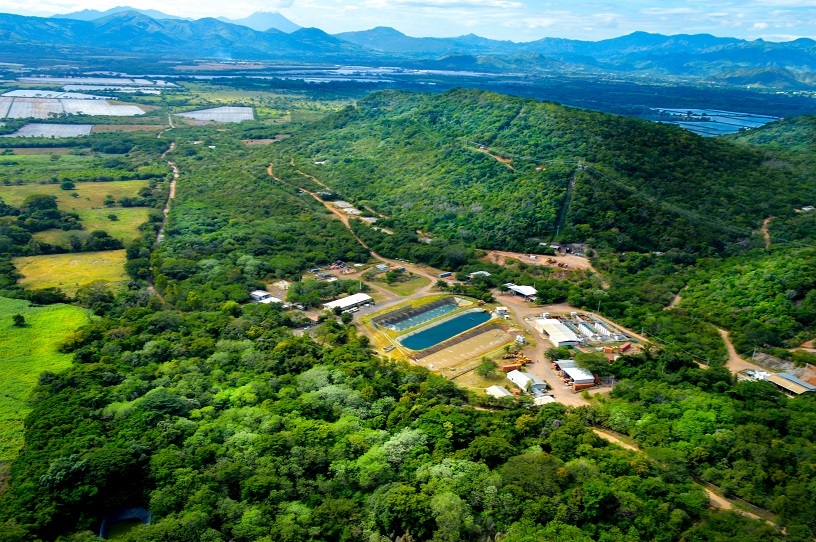And pretty soon others who know a thing or two about opportunities in the space were convinced, too.
Robins, a founder of Kaminak Gold and Stornoway Diamonds, had preconceptions about the country he admits were mostly wrong.
He also thought the Goldcorp project, untouched for five years, might be in a less than pristine state.
But it wasn't. Right down to the perfectly manicured office lawns and well maintained water treatment plant, "everything was as if they were still there carrying on with work".
"I kind of expected a neglected site, but everything was immaculate," Robins says.
"And I'd never been to Guatemala before, and had a whole bunch of preconceived ideas about what the country was like. Well it was nothing like I expected. Guatemala City was basically like a first world city, very modern; not what I expected.
"I was impressed with everything that I saw on that trip.
"And then there was the asset: a 1.2 million ounce resource averaging 10 grams per tonne [gold-equivalent], and it's fully permitted. From a personal point of view I'm 58 years old and I don't really want to be working on a project I've got to spend the next 10 years permitting like we did with Kaminak [from discovery].
"Cerro Blanco is fully permitted, high grade, [the preliminary economic assessment has it producing] up to 140,000ozpa, and you're all-in sustaining costs are going to potentially be sub-US$500/oz. That's going to produce better cash flow than a lot of mines producing 400,000ozpa.
"It's really attractive.
"We took a really good look at the historial CSR program and we were really impressed. The amount of work that went into the project, and the quality of the work that was done, was first class. The project has had over a decade of engagement with the local community."
The previous operator spent US$230 million on site and the PEA indicated it would require a further $171 million to get a 1,250tpd operation up and running. That initial expenditure covered 3km of underground development, various site facilities including the water treatment plant, and $60 million towards a geothermal energy project that could have an economic life of its own.
Most of the previous drilling focused on a 400m-by-800m section of the much larger landholding in Guatemala's Juatiapa Province. Robins says gold-bearing structures extend at least 2km north-west and 1km south of the Cerro Blanco deposit, and a big surface geochemical anomaly about 1km north of the main deposit requires further drilling.
Cerro Blanco itself has been logged as a classic hot springs-related, low sulphidation, epithermal gold-silver deposit, occurring in elevated terrain where high-grade veins were exposed underground between 300-500m elevation, dipping at up to 60 degrees, surrounded by a lower-grade gold halo.
"I'm an exploration geologist at heart and I look at this massive alteration system at Cerro Blanco, with a [1Moz] deposit kind of huddled in the southern part of it, and I think straight away, how's this varied mineralisation [the resource is in what is described as an intensely altered volcaniclastic sequence] accounting for an alteration system that carries on for kilometres to the north?
"Clearly to me there is a lot of room for this thing to grow," Robins says. "You've just got to unlock the story."
The plain truth about exploration at Cerro Blanco is that the project sat behind the operating Marlin gold mine in western Guatemala, since depleted and recently closed, as a priority for Goldcorp in-country. Despite its obvious economic appeal to a smaller company, it was evidently also not advancing in the broader Goldcorp pipeline.
Hence when the gold miner was ready to exit Marlin, it was persuaded to add some surplus equipment from that site, and its country-wide exploration database, to the Cerro Blanco package it was prepared to offload for US$18 million. The Marlin equipment cost another $2 million.
Similar asset disposals by big gold miners, and new management teams, over the past 3-5 years have created [relatively cheap] building blocks for what are now multi-billion-dollar market-cap ASX and TSX-listed mid-tiers.
Dewatering of the current underground drives down to about 420m (above sea level) will leave about one-third the current resource dewatered. One more 30m level down and it's 50%.
"About one-third of the deposit is above the water table right now," Robins says.
"A dewatering program has maintained the water level. It's not an overly wet mine, but it's a hot mine. The technical challenge with this project is going to be managing the heat, and the water is the source of the heat. Take that away and the rock cools down.
"A series of dewatering wells were drilled around the deposit but they weren't drilled deep enough. We're working with Stantec in Salt Lake City [formerly MWH Global] to get a better handle on the hydrology and we'll be doing some drilling which will kick off in the not too distant future. We're probably going to go in and infill the existing dewatering wells with deeper ones just to draw the cone of depression down deeper.
"On the operational side it's just a matter of doing the dewatering and then devising the appropriate mine ventilation and possibly some site-specific chilling of the working faces.
"The nice thing about 10gpt is that it gives you plenty of headroom to do those operational things."
Bluestone is not envisaging material changes to the PEA released as part of the acquisition, with a nine-year mine life, 105,000ozpa gold-equivalent (8.14gpt gold/27.95gpt silver) operation (138,000ozpa first four years) generating an internal rate of return of 44% with gold at $1,250/oz and AISC averaging $490/oz, and sustaining capex at $105 million, after the $171 million upfront capex.

Cerro Blanco site kept in 'immaculate' shape
"So if we found another significant deposit to the north, for example, I don't think you would see any change in the size of the plant initially. But it would allow us to push the mine life out beyond the nine years that we have right now.
"We think the exploration potential at the property is phenomenal.
"Another nice surprise we've had already is because everything was shotcreted underground, even though ground conditions are really good - there wasn't a lot of vein exposure underground. When we first started looking at the project we were looking for veins we thought should be exposed, but we didn't see them.
"But when we [removed sections of shotcrete] and started finding these vein exposures we expected to see, we also started finding a bunch of other veins that weren't in the records. We found almost two dozen veins that weren't reported, some thin, others thicker and high grade, but virtually none of them in the resource model.
"They will be somewhat challenging to bring into the resource, but my view is once you're mining here there's going to be a lot more gold mined than ever gets into the overall published resource because of the quantity of the veins in the system.
"Right now obviously we're focused very heavily on the feasibility work, but one of the things we've inherited is a country-wide database and nobody is doing regional exploration in Guatemala at the moment.
"The country is improving steadily in many aspects; it has the highest economic growth rate in Central America and one of the most stable currencies in Latin America over the past decade. It is incredibly well endowed geologically, and I believe that Cerro Blanco will allow us to have first mover advantage when the climate really does shift there, which I fully believe it will."
In addition to the work at Cerro Blanco, Bluestone will also complete a more comprehensive well flow-testing program on the Mita geothermal project to determine its capacity to supply a dedicated power plant. Goldcorp had a 50-year licence to build and operate a 50MW geothermal plant. When Guatemala's power grid got closer, and oil prices dipped, the big miner's attention was diverted elsewhere.
"Our back of the envelope estimates are that with the work completed to date there is probably 5-8MW of capacity right now once we do the flow tests," Robins says.
"The mine will probably consume about 10-12MW of power. The [privatised power] grid is 8km away and so the existing project study has the mine connecting into the grid. But, depending on results of the work we do, there is a very real opportunity to develop a geothermal resource that we can utilise, and potentially bring in a partner to develop a bigger standalone project.
"We've had lots of inbound calls from geothermal companies that would like to work with us, but until we know what we have we've just said, wait until we get the initial testwork done."
Bluestone is well-funded for all the work it has planned up to and through its feasibility study, courtesy of the equity-market support the management group garnered when it had to move quickly last year to secure the asset (C$80 million of equity funding accepted at the time). That included strong support from influential investor Lukas Lundin.
"That extra capital has given us the runway to take us all the way through feasibility. If we're lucky we could be sitting here at the end of the year making a production decision."
Suffice to say, Bluestone is wasting no time advancing its company-maker.
Its infill drilling is underway with three rigs on site: 6,000m of surface and 5,000m of underground drilling is planned this year. That will likely be complemented by regional exploration drilling at some stage soon, as Bluestone targets value-accretive mine life extension.
It expects to update the Cerro Blanco resource by mid-year and have its own feasibility study underway by the end of 2018.
ABOUT THIS COMPANY
Bluestone Resources
Bluestone Resources Inc. is a natural resource company focused on advancing the permitted, high-grade Cerro Blanco gold project and the Mita Geothermal project.
HEAD OFFICE:
- Suite 2000 - 885 West Georgia, Vancouver, British Columbia, V6C 3E8, Canada
- Telephone: +1 604 757 5559
- Web: bluestoneresources.ca
- Email: iinfo@bluestoneresources.ca



























